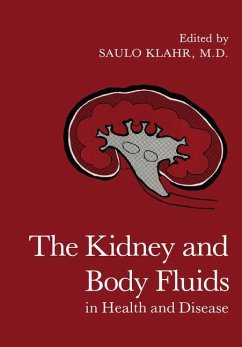Nephrotoxicity
In Vitro to In Vivo Animals to Man
Herausgegeben:Bach, Peter
Nephrotoxicity
In Vitro to In Vivo Animals to Man
Herausgegeben:Bach, Peter
- Broschiertes Buch
- Merkliste
- Auf die Merkliste
- Bewerten Bewerten
- Teilen
- Produkt teilen
- Produkterinnerung
- Produkterinnerung
There has been a growing awareness that nephrotoxicity represents a key factor in human nephropathies, where, irrespective of the causative agent, only a few clinical end-effects are diagnosed. Thus nephropathies are generally classified as acute or chronic renal failure, malignancies or immunological changes. The weaknesses in diagnosing nephropathies arises because of the effective role the kidney plays in maintaining homeostasis, despite the fact that it has been extensively damaged. The frequencies of some type of chemically-induced acute renal failure is well documented, but the causes of…mehr
Andere Kunden interessierten sich auch für
![Phosphate and Mineral Metabolism Phosphate and Mineral Metabolism]() Phosphate and Mineral Metabolism81,99 €
Phosphate and Mineral Metabolism81,99 €![Regulation of Phosphate and Mineral Metabolism Regulation of Phosphate and Mineral Metabolism]() Regulation of Phosphate and Mineral Metabolism81,99 €
Regulation of Phosphate and Mineral Metabolism81,99 €![Phosphate and Minerals in Health and Disease Phosphate and Minerals in Health and Disease]() Phosphate and Minerals in Health and Disease41,99 €
Phosphate and Minerals in Health and Disease41,99 €![The Kidney and Body Fluids in Health and Disease The Kidney and Body Fluids in Health and Disease]() The Kidney and Body Fluids in Health and Disease42,99 €
The Kidney and Body Fluids in Health and Disease42,99 €![Short Dialysis Short Dialysis]() Short Dialysis161,99 €
Short Dialysis161,99 €![Automation in blood transfusion Automation in blood transfusion]() C.Th. Smit Sibinga / P.C. Das / C.F. Högman (Hgg.)Automation in blood transfusion161,99 €
C.Th. Smit Sibinga / P.C. Das / C.F. Högman (Hgg.)Automation in blood transfusion161,99 €![Artificial Kidney, Artificial Liver, and Artificial Cells Artificial Kidney, Artificial Liver, and Artificial Cells]() Artificial Kidney, Artificial Liver, and Artificial Cells41,99 €
Artificial Kidney, Artificial Liver, and Artificial Cells41,99 €-
-
-
There has been a growing awareness that nephrotoxicity represents a key factor in human nephropathies, where, irrespective of the causative agent, only a few clinical end-effects are diagnosed. Thus nephropathies are generally classified as acute or chronic renal failure, malignancies or immunological changes. The weaknesses in diagnosing nephropathies arises because of the effective role the kidney plays in maintaining homeostasis, despite the fact that it has been extensively damaged. The frequencies of some type of chemically-induced acute renal failure is well documented, but the causes of chronic renal failure, malignancy, and other nephropathies are far more difficult to associate with a chemical aetiology. Many of the new therapeutic agents have important beneficial effects, but they are found to have marked nephrotoxic effects. Thus there is a growing urgency to increase the stringency of chemical safety evaluation for their potential nephrotoxic effects. This is stronglycountered by the increased financial pressure to identify potentially nephrotoxic chemicals earlier in their development and humanitarian considerations to more closely relate animal test to the clinical situation. Part of the challenge may be achieved by the increasing use of in vitro techniques.
Produktdetails
- Produktdetails
- Verlag: Springer / Springer US / Springer, Berlin
- Artikelnr. des Verlages: 978-1-4757-2042-6
- Softcover reprint of the original 1st ed. 1989
- Seitenzahl: 788
- Erscheinungstermin: 9. März 2013
- Englisch
- Abmessung: 244mm x 170mm x 42mm
- Gewicht: 1334g
- ISBN-13: 9781475720426
- ISBN-10: 1475720424
- Artikelnr.: 39561775
- Herstellerkennzeichnung Die Herstellerinformationen sind derzeit nicht verfügbar.
- Verlag: Springer / Springer US / Springer, Berlin
- Artikelnr. des Verlages: 978-1-4757-2042-6
- Softcover reprint of the original 1st ed. 1989
- Seitenzahl: 788
- Erscheinungstermin: 9. März 2013
- Englisch
- Abmessung: 244mm x 170mm x 42mm
- Gewicht: 1334g
- ISBN-13: 9781475720426
- ISBN-10: 1475720424
- Artikelnr.: 39561775
- Herstellerkennzeichnung Die Herstellerinformationen sind derzeit nicht verfügbar.
Species differences in renal structure and function - Applications to the assessment of nephrotoxicity in man.- Lead induced nephrotoxicity: kidney calcium as an indicator of tubular injury.- Predicting the kidney burden of toxic metals.- A prospective study of proteinuria in cadmium workers.- Red blood cell negative charges as an index of the glomerular polyanion in chronic cadmium poisoning.- Some considerations on critical concentration of cadmium for renal toxicity in rats.- Historical perspective on cadmium-induced nephrotoxicity.- Cadmium may predispose mice to immune complex-mediated renal injury: another possible mechanism for cadmium-induced nephrotoxicity.- Nephrotoxicity of cadmium in chickens.- Differential effects of cadmium and mercury on lysosomal enzymes in the kidney of Myxine glutinosa.- The effects of cadmium and adriamycin on the isolated perfused glomerulus of Myxine glutinosa (Cyclostomata).- Protective effect of low concentrations of mercury against mercuric chloride-induced nephrotoxicity.- Induction of antinuclear antibodies by mercuric chloride in mice.- Analysis of unscheduled DNA synthesis and S-phase synthesis in F344 rat kidney after in vivo treatment with mercuric chloride.- In vitro and in vivo mercuric chloride-induced nephrotoxicity assessed by tubular enzymes release.- Prevention and reversal of mercuric chloride-induced increases in renal vascular resistance by captopril.- Regioselective acute tubular necrosis in renal cortical slices following mercuric chloride and potassium dichromate: localization and transport studies.- In-vivo bone lead measurements and renal effects.- Early indicators of lead nephropathy.- Nephrotoxicity of uranyl fluoride and reversibility of renal injury in the rat.- Low molecular weight proteins in thekidney of copper-loaded rats.- Gold nephropathy - effect of gold on immune response to renal tubular basement membrane (TBM) antigen in mice.- Drug induced renal effects of cyclosporine, aminoglycoside antibiotics and lithium: extrapolation of animal data to man.- Lithium-induced distal nephron dilatation in young rabbits with associated encephalitazoan cuniculi related interstitial fibrosis.- Urinary phospholipids patterns after treatment with aminoglycoside antibiotics and cis-platinum.- Comparative uptake and lysosomal phospholipidosis induced by gentamicin components C1, C1a and C2.- Uptake and subcellular distribution of poly-L-aspartic acid, a protectant against aminoglycoside-induced nephrotoxicity, in rat kidney cortex.- Aminoglycoside antibiotics inhibit the phophatidylinositol cascade in renal proximal tubular cells : possible role in toxicity.- Silymarin ameliorates gentamicin nephrotoxicity.- Possible role of the renin-angiotensin system in the development of gentamicin nephrotoxicity in the rat.- Effect of furosemide and verapamil on gentamicin nephrotoxicity.- Renal phospholipidosis in rats after gentamicin and pefloxacin coadministration at low doses.- Morphological and functional impairments of the developing rat kidney exposed to gentamicin in utero.- Morphological and functional effects in rat neonates of aminoglycosides given to the mother during gestation.- Gentamicin-stimulated increase in para-aminohippurate uptake in renal cortical slices and isolated proximal tubular cells.- Investigation of gentamicin nephrotoxicity using renal brush border membrane vesicles.- Time dependent nephrotoxicity of amikacin.- Effect of latamoxef [Moxalactam] on tobramycin binding to kidney brush border membranes in rats.- Amphotericin-B nephrotoxicity is decreasedby intravenous flucytosine in the rat.- Apparent amoxapine nephrotoxicity: dependence on rhabdomyolysis and acidosis.- Mechanisms of cyclosporin A nephrotoxicity - rat to man.- The effects of cyclosporin A on the urine excretion of specific proteins in humans.- Renal tubular function in experimental and clinical cyclosporin nephrotoxicity.- The effect of biliary cannulation or ligation on cyclosporin A (CsA) nephrotoxicity in the rat.- Cyclosporine A-induced lipid peroxidation in rat renal microsomes and effect on glucose uptake by renal brush border membrane vesicles.- Chronic renal tubular damage caused by cyclosporin A.- Effects of acute and chronic cyclosporine administration on glomerular haemodynamics in rats.- Intracellular localization of cyclosporin A in the rat kidney.- Distribution of platinum amongst the subcellular organelles of the rat kidney after oral administration of cisplatin.- Alpha-methylglucose uptake by isolated rat kidney proximal tubular cells as a parameter for cell integrity in vitro.- Lipid peroxidation as a mechanism of cisplatin-induced nephrotoxicity.- Renal toxicity of cis-dichlorodiammine platinum in rats.- Uptake of cisplatin (195mpt) into LLCPK1 cells in the presence of diethyldithiocarbamate, (DDTC) mercaptoethane-sulphate (MESNA) and amiloride.- The effect of amiloride on cisplatin induced nephrotoxicity and the renal uptake of cisplatin (195mpt) in male Wistar rats.- The response of the pig kidney to a combination of cisplatin and irradiation.- The effect of acetazolamide and furosemide on lithium clearance and cisplatin nephrotoxicity in the rat.- Sensitivity of in vitro ion accumulation, gluconeogenesis and other parameters as indicators of cisplatin-induced renal toxicity.- Assessment of nephrotoxicity by analysis of arandomised multi-centre comparative study regarding the previous extent of kidney damage.- Drug pharmacokinetics in renal failure - influence of disease type.- Analgesic related renal injury in man.- Progression of renal failure in analgesic associated nephropathy.- The renal reponse of a nonhuman primate (baboon) to certain nonsteroidal anti-inflammatory drugs.- Morphological changes in the pig kidney associated with an acutely induced renal papillary necrosis.- Upper urothelial carcinoma, using N-butyl-N-(4-hydroxybutyl)-nitrosamine and an acute papillary necrosis.- High resolution microscopic changes in an acutely induced renal papillary necrosis: morphology and enzyme histo-chemistry.- Cannulation of the bile duct protects against para-aminophenol-induced nephrotoxicity in the Fischer 344 rat.- Effects of antidotes on the hepato- and nephro-toxicity of paracetamol in the rat.- Celiptium induced lipid peroxidation and toxicity in rat renal cortex.- Nephrotoxicity of ifosfamide in combination chemotherapy.- Risk evaluation of muzolimine and furosemide in experimental models of nephrotoxicity.- The role of oxidative stress in cephaloridine nephrotoxicity.- Studies on the mechanism of radiological contrast media induced renal failure.- Radiocontrast nephrotoxicity in diabetes: clinical considerations and studies in the diabetic rat.- Renal microcirculation during urographic contrast media administration.- Hypertonic radiocontrast medium and the kidney: effects on renal function in the euvalaemic and in the dehydrated dogs.- Renal effects of ionic and nonionic contrast media: comparison between diatrizoate meglumine and Iopamidol.- Renal proton nuclear magnetic resonance in gentamicin, cyclosporin A and cisplatinum, acute renal failure in rats.- 31Phosphorus NMRstudies of mercuric chloride nephrotoxicity in the in vitro perfused rat kidney.- Application of 1H NMR urinalysis to the examination of nephrotoxic lesions induced by mercuric chloride, hexachloro-1, 3-butadiene, and propyleneimine.- Pathogenesis of protein droplet nephropathy and its relationship to renal carcinogenesis in the male rat.- Light hydrocarbon-induced nephrotoxicity: the interaction of 2,2,4-trimethylpentane with alpha-2u-globulin in the male rat kidney.- Male rat specific alpha-2u-globulin nephropathy and renal tumorigenesis.- Nephrotoxicity and studies on the reabsorption and disposal of alpha-2u-globulin.- Induction of hyaline droplet accumulation in renal cortex of male rats by aromatic compounds.- 1,4-Dichlorobenzene-induced nephrotoxicity: similarity with unleaded gasoline-induced renal effects.- Comparison of the subacute nephrotoxicity of industrial solvents in the rat.- Nephrotoxic responses to multiple chemical exposure.- Dichlorovinyl cysteine accumulation and ?-lyase activity in the developing mouse kidney.- Regioselective toxicity by dichlorovinylcysteine in rabbit renal cortical slices.- Use of LLC-PK1 monolayers as an in vitro model for nephrotoxicity.- Bioactivation, mechanism and cytotoxicity of S-(2-chloro-1,1,2-trifluoroethyl)-L-cysteine.- Role of biotransformation in acute N-(3,5-dichlorophenyl)-succinimide-induced nephrotoxicity.- Chloroform nephrotoxicity and renal uptake of calcium.- Renal pathology of orally administered L-triiodothyronine in the rat.- Lipid peroxidation as a possible cause of ochratoxin A toxicity.- Silicon in uremic rats.- Nephrotoxicity of experimental endotoxaemia in rats.- Studies on a physiologic model for the human renal Fanconi syndrome.- Chronic ureter cannula in pig.- Effects of glycerol-induced acuterenal failure on renal phosphorus handling.- Renal haemodynamics and renin response during acute hypercapnea in dogs.- The isolated perfused rat kidney: filtering and non-filtering models in the assessment of altered renal vascular resistance in nephrotoxicity.- Endotoxin-hemoglobin induced nephropathy and haptoglobin administration.- Partially purified bovine atrial fraction on animal kidney, smooth muscle and sodium transport in toad skin.- Investigations on the nephrotoxic potential of recombinant human tumor necrosis factor.- Characterisation of human renal embryonic antigens by monoclonal antibodies.- Species differences in the immunocytochemical distribution of Tamm-Horsfall glycoprotein.- Immunocytochemical localization of glutathione peroxidase in uremic rat kidney.- Urine glutathione-S-transferase associated with nephrotoxic drugs.- Age-related changes in renal brush borders brush border enzymes.- Characterization of isolated renal proximal tubules for nephrotoxicity studies.- Isolated rat renal proximal tubular cells: a model to investigate drug-induced nephrotoxicity.- Ion deregulation in injured proximal tubule epithelial cells.- Lipophilic cations as membrane probes in cultured renal (LLC-PK1) and muscle cells (L6).- Characterization of an unscheduled DNA synthesis assay with a cultured line of porcine kidney cells (LLC-PK1).- Micropuncture studies on mechanisms of proteinuria in early adriamycin-nephrosis in MWF-rats.
Species differences in renal structure and function - Applications to the assessment of nephrotoxicity in man.- Lead induced nephrotoxicity: kidney calcium as an indicator of tubular injury.- Predicting the kidney burden of toxic metals.- A prospective study of proteinuria in cadmium workers.- Red blood cell negative charges as an index of the glomerular polyanion in chronic cadmium poisoning.- Some considerations on critical concentration of cadmium for renal toxicity in rats.- Historical perspective on cadmium-induced nephrotoxicity.- Cadmium may predispose mice to immune complex-mediated renal injury: another possible mechanism for cadmium-induced nephrotoxicity.- Nephrotoxicity of cadmium in chickens.- Differential effects of cadmium and mercury on lysosomal enzymes in the kidney of Myxine glutinosa.- The effects of cadmium and adriamycin on the isolated perfused glomerulus of Myxine glutinosa (Cyclostomata).- Protective effect of low concentrations of mercury against mercuric chloride-induced nephrotoxicity.- Induction of antinuclear antibodies by mercuric chloride in mice.- Analysis of unscheduled DNA synthesis and S-phase synthesis in F344 rat kidney after in vivo treatment with mercuric chloride.- In vitro and in vivo mercuric chloride-induced nephrotoxicity assessed by tubular enzymes release.- Prevention and reversal of mercuric chloride-induced increases in renal vascular resistance by captopril.- Regioselective acute tubular necrosis in renal cortical slices following mercuric chloride and potassium dichromate: localization and transport studies.- In-vivo bone lead measurements and renal effects.- Early indicators of lead nephropathy.- Nephrotoxicity of uranyl fluoride and reversibility of renal injury in the rat.- Low molecular weight proteins in thekidney of copper-loaded rats.- Gold nephropathy - effect of gold on immune response to renal tubular basement membrane (TBM) antigen in mice.- Drug induced renal effects of cyclosporine, aminoglycoside antibiotics and lithium: extrapolation of animal data to man.- Lithium-induced distal nephron dilatation in young rabbits with associated encephalitazoan cuniculi related interstitial fibrosis.- Urinary phospholipids patterns after treatment with aminoglycoside antibiotics and cis-platinum.- Comparative uptake and lysosomal phospholipidosis induced by gentamicin components C1, C1a and C2.- Uptake and subcellular distribution of poly-L-aspartic acid, a protectant against aminoglycoside-induced nephrotoxicity, in rat kidney cortex.- Aminoglycoside antibiotics inhibit the phophatidylinositol cascade in renal proximal tubular cells : possible role in toxicity.- Silymarin ameliorates gentamicin nephrotoxicity.- Possible role of the renin-angiotensin system in the development of gentamicin nephrotoxicity in the rat.- Effect of furosemide and verapamil on gentamicin nephrotoxicity.- Renal phospholipidosis in rats after gentamicin and pefloxacin coadministration at low doses.- Morphological and functional impairments of the developing rat kidney exposed to gentamicin in utero.- Morphological and functional effects in rat neonates of aminoglycosides given to the mother during gestation.- Gentamicin-stimulated increase in para-aminohippurate uptake in renal cortical slices and isolated proximal tubular cells.- Investigation of gentamicin nephrotoxicity using renal brush border membrane vesicles.- Time dependent nephrotoxicity of amikacin.- Effect of latamoxef [Moxalactam] on tobramycin binding to kidney brush border membranes in rats.- Amphotericin-B nephrotoxicity is decreasedby intravenous flucytosine in the rat.- Apparent amoxapine nephrotoxicity: dependence on rhabdomyolysis and acidosis.- Mechanisms of cyclosporin A nephrotoxicity - rat to man.- The effects of cyclosporin A on the urine excretion of specific proteins in humans.- Renal tubular function in experimental and clinical cyclosporin nephrotoxicity.- The effect of biliary cannulation or ligation on cyclosporin A (CsA) nephrotoxicity in the rat.- Cyclosporine A-induced lipid peroxidation in rat renal microsomes and effect on glucose uptake by renal brush border membrane vesicles.- Chronic renal tubular damage caused by cyclosporin A.- Effects of acute and chronic cyclosporine administration on glomerular haemodynamics in rats.- Intracellular localization of cyclosporin A in the rat kidney.- Distribution of platinum amongst the subcellular organelles of the rat kidney after oral administration of cisplatin.- Alpha-methylglucose uptake by isolated rat kidney proximal tubular cells as a parameter for cell integrity in vitro.- Lipid peroxidation as a mechanism of cisplatin-induced nephrotoxicity.- Renal toxicity of cis-dichlorodiammine platinum in rats.- Uptake of cisplatin (195mpt) into LLCPK1 cells in the presence of diethyldithiocarbamate, (DDTC) mercaptoethane-sulphate (MESNA) and amiloride.- The effect of amiloride on cisplatin induced nephrotoxicity and the renal uptake of cisplatin (195mpt) in male Wistar rats.- The response of the pig kidney to a combination of cisplatin and irradiation.- The effect of acetazolamide and furosemide on lithium clearance and cisplatin nephrotoxicity in the rat.- Sensitivity of in vitro ion accumulation, gluconeogenesis and other parameters as indicators of cisplatin-induced renal toxicity.- Assessment of nephrotoxicity by analysis of arandomised multi-centre comparative study regarding the previous extent of kidney damage.- Drug pharmacokinetics in renal failure - influence of disease type.- Analgesic related renal injury in man.- Progression of renal failure in analgesic associated nephropathy.- The renal reponse of a nonhuman primate (baboon) to certain nonsteroidal anti-inflammatory drugs.- Morphological changes in the pig kidney associated with an acutely induced renal papillary necrosis.- Upper urothelial carcinoma, using N-butyl-N-(4-hydroxybutyl)-nitrosamine and an acute papillary necrosis.- High resolution microscopic changes in an acutely induced renal papillary necrosis: morphology and enzyme histo-chemistry.- Cannulation of the bile duct protects against para-aminophenol-induced nephrotoxicity in the Fischer 344 rat.- Effects of antidotes on the hepato- and nephro-toxicity of paracetamol in the rat.- Celiptium induced lipid peroxidation and toxicity in rat renal cortex.- Nephrotoxicity of ifosfamide in combination chemotherapy.- Risk evaluation of muzolimine and furosemide in experimental models of nephrotoxicity.- The role of oxidative stress in cephaloridine nephrotoxicity.- Studies on the mechanism of radiological contrast media induced renal failure.- Radiocontrast nephrotoxicity in diabetes: clinical considerations and studies in the diabetic rat.- Renal microcirculation during urographic contrast media administration.- Hypertonic radiocontrast medium and the kidney: effects on renal function in the euvalaemic and in the dehydrated dogs.- Renal effects of ionic and nonionic contrast media: comparison between diatrizoate meglumine and Iopamidol.- Renal proton nuclear magnetic resonance in gentamicin, cyclosporin A and cisplatinum, acute renal failure in rats.- 31Phosphorus NMRstudies of mercuric chloride nephrotoxicity in the in vitro perfused rat kidney.- Application of 1H NMR urinalysis to the examination of nephrotoxic lesions induced by mercuric chloride, hexachloro-1, 3-butadiene, and propyleneimine.- Pathogenesis of protein droplet nephropathy and its relationship to renal carcinogenesis in the male rat.- Light hydrocarbon-induced nephrotoxicity: the interaction of 2,2,4-trimethylpentane with alpha-2u-globulin in the male rat kidney.- Male rat specific alpha-2u-globulin nephropathy and renal tumorigenesis.- Nephrotoxicity and studies on the reabsorption and disposal of alpha-2u-globulin.- Induction of hyaline droplet accumulation in renal cortex of male rats by aromatic compounds.- 1,4-Dichlorobenzene-induced nephrotoxicity: similarity with unleaded gasoline-induced renal effects.- Comparison of the subacute nephrotoxicity of industrial solvents in the rat.- Nephrotoxic responses to multiple chemical exposure.- Dichlorovinyl cysteine accumulation and ?-lyase activity in the developing mouse kidney.- Regioselective toxicity by dichlorovinylcysteine in rabbit renal cortical slices.- Use of LLC-PK1 monolayers as an in vitro model for nephrotoxicity.- Bioactivation, mechanism and cytotoxicity of S-(2-chloro-1,1,2-trifluoroethyl)-L-cysteine.- Role of biotransformation in acute N-(3,5-dichlorophenyl)-succinimide-induced nephrotoxicity.- Chloroform nephrotoxicity and renal uptake of calcium.- Renal pathology of orally administered L-triiodothyronine in the rat.- Lipid peroxidation as a possible cause of ochratoxin A toxicity.- Silicon in uremic rats.- Nephrotoxicity of experimental endotoxaemia in rats.- Studies on a physiologic model for the human renal Fanconi syndrome.- Chronic ureter cannula in pig.- Effects of glycerol-induced acuterenal failure on renal phosphorus handling.- Renal haemodynamics and renin response during acute hypercapnea in dogs.- The isolated perfused rat kidney: filtering and non-filtering models in the assessment of altered renal vascular resistance in nephrotoxicity.- Endotoxin-hemoglobin induced nephropathy and haptoglobin administration.- Partially purified bovine atrial fraction on animal kidney, smooth muscle and sodium transport in toad skin.- Investigations on the nephrotoxic potential of recombinant human tumor necrosis factor.- Characterisation of human renal embryonic antigens by monoclonal antibodies.- Species differences in the immunocytochemical distribution of Tamm-Horsfall glycoprotein.- Immunocytochemical localization of glutathione peroxidase in uremic rat kidney.- Urine glutathione-S-transferase associated with nephrotoxic drugs.- Age-related changes in renal brush borders brush border enzymes.- Characterization of isolated renal proximal tubules for nephrotoxicity studies.- Isolated rat renal proximal tubular cells: a model to investigate drug-induced nephrotoxicity.- Ion deregulation in injured proximal tubule epithelial cells.- Lipophilic cations as membrane probes in cultured renal (LLC-PK1) and muscle cells (L6).- Characterization of an unscheduled DNA synthesis assay with a cultured line of porcine kidney cells (LLC-PK1).- Micropuncture studies on mechanisms of proteinuria in early adriamycin-nephrosis in MWF-rats.








